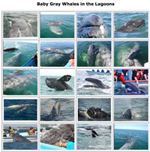| Please
Report Your Sightings! |
Pacific
gray whales are still southbound and the news from
the whale trail is all good! Delighted observers predict a
record year. Discover why gray
whales
rule when
it comes to amazing animal migrations in a new
slideshow. Take a team treasure hunt for facts about our whale
observation posts as you get set for the 2011 journey north. Welcome!
This
Week's Report Includes:
- Longest Mammal Migration: Where Are They Now?
- Slideshow: The Monumental Migration
- Sightings: Still Heading South
- The Migration Route: Explore With a Treasure Hunt
- Tracking the Migration: Using Daily Data
- Links: This Week's Gray Whale Resources
 |
How
old is this baby gray whale? Photo Jim Dorsey, Baja Ecotours, Laguna San Ignacio |
|
As you sit in cozy classrooms today, where are the Pacific Gray whales? You might be surprised that many are still plowing south on their nearly 6,000-mile swim from Alaska to Mexico. Just two gray whales have been seen on the journey north so far. As whales return northward up the coast to the Arctic, we'll share sightings and news from a network of observers lucky to work or live along the whale trail. Will this season count more whales than the past two lean years? Observers who've reported so far are all predicting YES. It promises to be an exciting migration adventure: Journey North 2011! |
Most gray whales are on the way, or have arrived, in the lagoons of Mexico's Baja peninsula right now. They began arriving in December to mate, give birth, and nurture their newborns in these special waters.
Isn't it
amazing? A
gray whale's life is always in motion! The changing seasons drive the
whales'
endless migration — a route to survival. What can these gentle
giants teach us about
survival? See why this marine mammal's migration is as monumental
as the gray whales themselves. Dive into a story too good to miss:
Gray
Whales: The Monumental Migration.
Whale observers along the California coast at Post #6 have spotted just two whales headed north to date. Project Director Alisa Schulman-Janiger reminds us: "We should continue to see mostly southbound gray whales until mid-February."
Meanwhile, the real action right now is in the warm lagoons of Mexico's Baja Peninsula. The whales swim so far south to mate and give birth — two important life cycle events. Most births take place in two lagoons. But Caitlin's news from San Diego (click Post #5 on the map) tells that some births happen on the way. And the number of calves (babies) being born in the lagoons is happy news indeed. You can view the first counts at Post #2 and Post #3 in their Field Notes. "It is exciting to see the whale count more than triple what it was last year at the same dates," reports whale watching guide Keith "Baja" Jones from Laguna Ojo de Liebre (Post #3). More news next time!
What discoveries can you make about gray whale migration by visiting each of the Observation Posts along the route? Team up and take our Treasure Hunt challenge for some fun surprises!
Collect facts on the note-taking chart, then share and compare with other teams: How many facts did you find? How many were unique to your group? How many were the same as other teams found? Tally your scores and celebrate your new knowledge of the whale trail!
Before you Begin. What's new? Are you ready to track the migration? Get acquainted with the data you'll see and where it's from. Start here: About This Study. In each update, we will …
1. View the latest daily migration data.
2. Record, graph and analyze the data. (See instructions.)
3. Explore
This Week's Questions.
It's still
early in the data collection, but the Summary and Analysis Chart offers
a gentle start. Record your responses:
- What do the data from Los Angeles observers show about gray whale traffic so far? (Summary of Data)
- What surprises you? How might you explain it? (Analysis of Data)
- What's New? Orientation: About Journey North's Gray Whale Migration Study
- Resources for Using Daily Data: Tracking Gray Whale Migration from California Observation Posts
- Introductory Slideshow and More: Gray Whales: The Monumental Migration.
- Exploring the Migration Route: Treasure Hunt Activity
- Personal Reflection: Your Gray Whale Journal
- Gray Whales for Kids: Slideshows, photos, video clips)
The Next Gray Whale Migration Update Will Be Posted on February 16, 2011.








